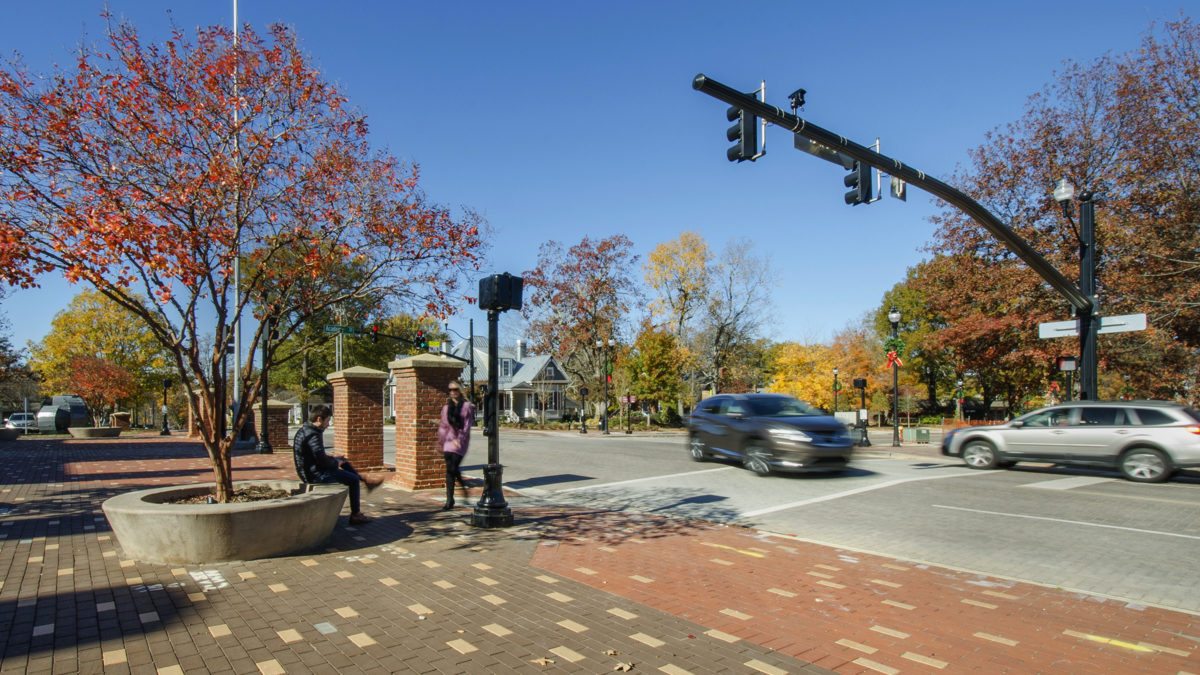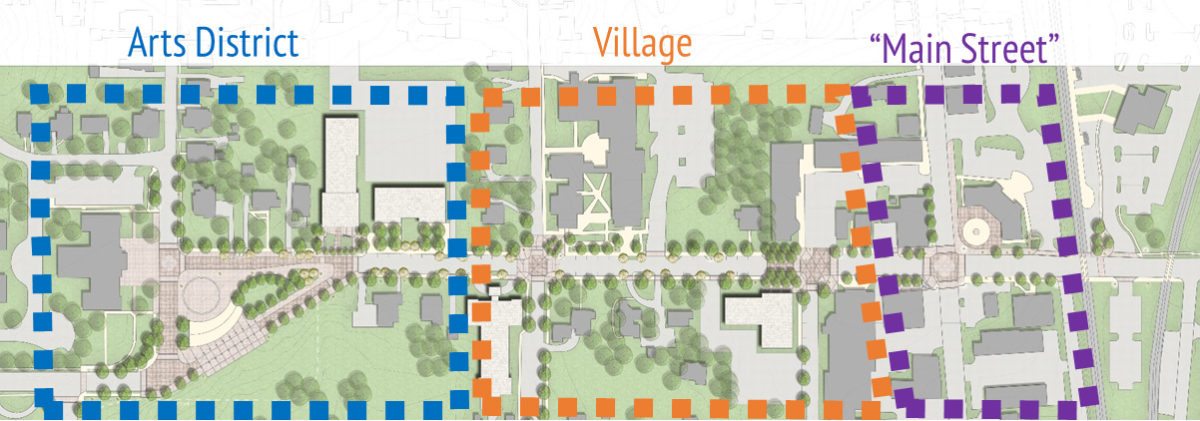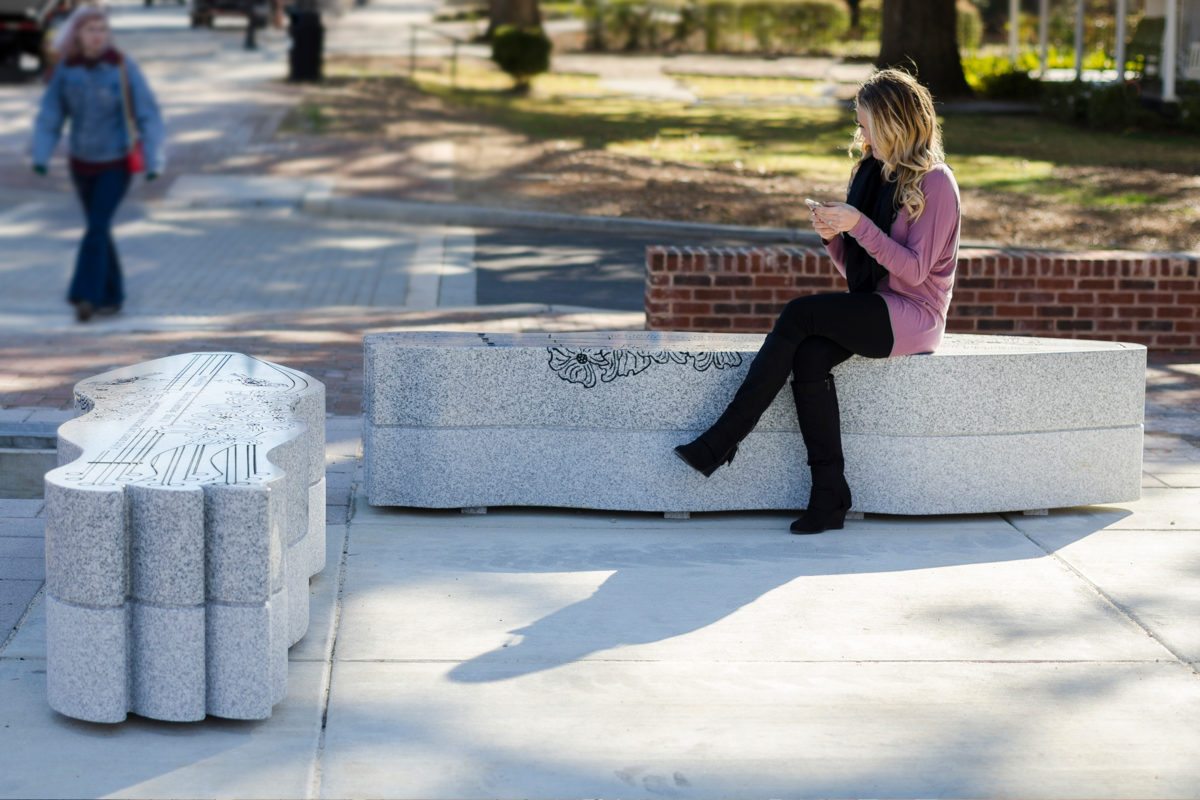Transforming the Pedestrian Experience: Academy Street Reimagined
 Downtown revitalization is a hot topic in urban design, with big and small cities seeking to redevelop and re-energize their cultural cores. Tied to both the resident experience and economic development, these efforts emphasize key characteristics such as walkability and varied, diverse attractions. In the Town of Cary, North Carolina, the reimagining of Academy Street is a key step in revitalizing their historic downtown. The result of years of planning and design, this transformed space heralds a new era for downtown.
Downtown revitalization is a hot topic in urban design, with big and small cities seeking to redevelop and re-energize their cultural cores. Tied to both the resident experience and economic development, these efforts emphasize key characteristics such as walkability and varied, diverse attractions. In the Town of Cary, North Carolina, the reimagining of Academy Street is a key step in revitalizing their historic downtown. The result of years of planning and design, this transformed space heralds a new era for downtown.
Working closely with the Town of Cary, Clark Nexsen crafted a design concept to transform Academy Street into the signature street envisioned as part of the Town Center Area Plan. Originally adopted in the early 2000s, the Area Plan outlined a vision for Cary’s downtown as a vibrant, unique, dynamic, pedestrian-friendly environment that promotes the emerging arts district and acts as a destination for both residents and visitors. To enhance the pedestrian experience and re-energize the streetscape, our design team sought input from stakeholders including the public, Town representatives from multiple departments, and the Town Council to create an engaging connector between the Arts District, Village, and “Main Street” areas.
 Centered on a unified vision of a vibrant public space, the team developed a concept of interwoven design elements forming a path between the Arts District, Village, and Main Street. These varied elements create opportunities for engagement, support foot traffic near local businesses, and honor Cary’s past while looking to the future. This melding of tradition with rich cultural experiences and commercial destinations is a trademark of successful downtown revitalizations.
Centered on a unified vision of a vibrant public space, the team developed a concept of interwoven design elements forming a path between the Arts District, Village, and Main Street. These varied elements create opportunities for engagement, support foot traffic near local businesses, and honor Cary’s past while looking to the future. This melding of tradition with rich cultural experiences and commercial destinations is a trademark of successful downtown revitalizations.
Fostering New Connections with Outdoor Rooms
At the core of the reimagined streetscape concept are “outdoor rooms,” proposed by Clark Nexsen’s landscape architects during the early design phases to create unique environments in which groups can gather and enjoy the active downtown scene. Connected by wide sidewalks that feature intermittent seating, these outdoor rooms reinforce Academy Street’s sense of place and highlight the beauty of urban outdoor space. With integrated art and seating in attractive arrangements, the rooms serve as a distinguishing element and have been rapidly embraced by local residents as gathering spaces.
Public Art Celebrates Cary’s Rich Culture
The integration of public art is a major component in the transformation of the pedestrian experience from mundane to engaging. To ensure thoughtful and strategic implementation, the Town of Cary asked Clark Nexsen to solicit artists’ proposals and select and contract with an artist (with the Town’s input). Kyle Hubert, an engineer for the Town of Cary, noted this choice made the design process more cohesive, as the arts element was continuously integrated with disciplines such as landscape architecture and civil and electrical engineering. This close collaboration between artistic and technical disciplines is representative of the successful collaboration of the greater group of stakeholders as they worked toward a shared vision.
Today, artistic elements abound throughout the streetscape, intentionally reflecting Academy Street’s frequent use as a festival and public performance venue and acting as a catalyst for conversation. Jack Mackie, the team’s artist, completed extensive research regarding the area’s history to incorporate art that would resonate with residents. These efforts involved coordination with Cary Visual Arts, a nonprofit that organizes rotating art displays along Academy Street, and the integration of art via granite benches carved in the shape of musical instruments and engraved with relevant quotes related to music or Cary’s history. As functional art that is also reflective of Cary’s music scene, these granite benches serve multiple purposes, providing seating, stimulating conversation, and contributing to the aesthetics of the streetscape.
 Design Accommodates Popular Festivals
Design Accommodates Popular Festivals
In addition to serving as a main connector, Academy Street’s contribution to downtown is closely tied to its popularity as a festival site. Hosting festivals as large as Lazy Daze, attended by more than 50,000 people, the reimagined Academy Street is set up to more seamlessly accommodate festivals and enhance the pedestrian experience beyond the sidewalks. From burying utilities to enhancing electrical infrastructure to support vendors and food trucks, the project benefited from an integrated design process in which civil, electrical, and structural engineers worked closely together to develop solutions that met the Town’s needs.
One critical need was raised by Cary’s festivals and events staff, who explained they often bring in generators to deliver power to band stages, food trucks, and other equipment during festivals – a less than ideal solution in terms of acoustics and visuals as well as cost. To address this challenge, our electrical engineers created a system of utility power boxes, located at specified points along Academy Street, to provide better electrical infrastructure to festival participants. Working closely with the landscape architects, the team was able to position many of these boxes such that they are masked by landscape elements including benches or shrubs, streamlining the street’s appearance.
Establishing a Sense of Place
As a signature street, Academy Street is representative of the larger goals for Cary’s downtown – to be a vibrant, distinctive destination that promotes organic gatherings, street music, and economic development. Fundamental in the project’s success was the extensive stakeholder involvement and iterative design process undertaken between the Town and Clark Nexsen’s design team. With multiple public meetings, seven work sessions with the Town Council, and monthly meetings involving Town stakeholders ranging from utilities, to transportation, to cultural arts, to parks and recreation, the design process benefited from early, regular input from all parties and a shared vision. This vision is realized in a signature street that seamlessly blends old and new to establish a strong sense of place.
Josh Hurst, PE, PTOE, LEED AP BD+C, joined Clark Nexsen in 2003 and contributed to the growth of our Transportation - Roads practice. In 2019, he presented the Academy Street project with Kyle Hubert of the Town of Cary at APWA’s national conference. Josh left Clark Nexsen in 2020 for other opportunities.
